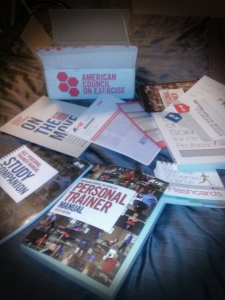Study Recap Saturday: Miscellaneous Muscle-Mania
 This past week, I was studying the muscular system. It’s very interesting. I think I see the body as an amazing universe. It’s so complex and there is so much going on. It’s amazing how every part of our body has to work in harmony in order for us to function properly, and ultimately, to live. It’s fascinating! The muscles are no different. They are complex and amazing.
This past week, I was studying the muscular system. It’s very interesting. I think I see the body as an amazing universe. It’s so complex and there is so much going on. It’s amazing how every part of our body has to work in harmony in order for us to function properly, and ultimately, to live. It’s fascinating! The muscles are no different. They are complex and amazing.
Sharing 10 interesting facts related to my studies last week worked out well. I’ve decided to go that route again, rather than write a novel trying to summarize the muscular system, as there is just so much to it.
- There are 3 types of muscles. There are smooth muscles, which function without any effort on your part, as they are also called involuntary. They are found in your hollow organs, like your stomach. There are cardiac muscles. They are also involuntary, but they are specifically responsible for keeping your heart pumping. There are also skeletal muscles. These are the muscles most people think of when they think of muscles. They are attached to your bones, and they are the ones that you can workout with exercise. Hence, they are voluntary.
- Skeletal muscles are also sometimes called striated muscles. That’s because under a microscope, they look somewhat striped, with light and dark colored bands.
- Your muscles have 2 types of fibers, fast and slow-twitch. Well, sort of. Fast twitch actually refers to type IIx and IIa. The slow-twitch fibers are basically endurance fibers. They don’t tire very quickly, but they also aren’t as strong as fast-twitch fibers. Type IIx is very strong and powerful, but it’s efforts and force can only last a few seconds. Think power lifter. The type, IIa is a happy medium between slow-twitch and IIx. Ultimately, for total muscle activation, you want to activate all of the muscle fibers. This means doing a combination of low-rep, heavy lifts, moderate-reps, moderate weight lifts, and high-rep, low weight or no weight lifts.
- While we’re on the subject of fast and slow-twitch muscle fibers, I should tell you that different people have different percentages of each of these fibers. Your specific percentage could possibly be determined by your genetics, hormones, or perhaps your activity level. However, it is only a variable, and does not necessarily determine what you are capable of physically.
- Collagen is a soft substance in your body. A lot of ligaments and tendons that are subjected to stretching are made of collagen. It is stretchy, but not very. Hopefully, that makes sense. Basically, it has a little give. It only stretches about 3% of it’s size.
- No doubt you’ve noticed that younger people tend to be more flexible than older people. Did you know that as you age, muscle tissue is replaced with fatty, fibrous, collagen tissue. It doesn’t have the give and elasticity it once had. However, regular physical activity and stretching can really help with this!
- Injuries can also impair flexibility. Damage to a joint or bone could lead to the body repairing the injury by laying down calcium, limiting flexibility. Scar tissue is another injury scenario where an injury can impair flexibility. Scar tissue has limited elasticity. However, regular stretching can increase flexibility to some degree, even following an injury.
- Muscles stretch best once they’ve been warmed up (hence the hot yoga craze). The ideal temperature is 103′. You don’t have to get into hot yoga to get a good stretch, though. If you get your body temperature up by biking, walking, or doing some plyometrics. The key is to break a sweat, not exhaust yourself. It’s a warm up. Another great time to stretch is after your workout, following your cool down. Your body temperature is up and ready for a good stretch.
- There’s a term, circadian variation. It refers to a day (24 hours). In that day, your body has some different fluctuations. Things like blood pressure, body temperature, heart rate, hormone levels, alertness, and even joint stiffness can change. Among those fluctuations, it turns out, most people are actually more flexible in the afternoon.
- Back to that circadian variation. Have you ever heard that people are slightly taller in the morning than they are before bed? As it turns out, there’s fluid between your intervertebral disks. While your body is upright during the day, between the muscular force and pressure, plus the gravitational pull, fluid is squeezed out of the disks. Then, at night, while laying down, resting, your body is able to rehydrate them.
Hopefully you all learned something new. I know, I did. Thanks for supporting me in my studies!






Thank you Mireille for this post on muscles. I enjoyed reading it and have learned quite a few things from it which really helps us in our daily lives. 🙂
LikeLiked by 1 person
Thanks! I love my Saturday Study Recaps, too. They really help me get more out of my studies through putting together the posts, reviewing my studies, and writing it to share with all of you.
LikeLike
Great information and very helpful.
LikeLiked by 1 person
Thank you so much!
LikeLike
Very interesting facts. Thanks for sharing.
LikeLiked by 1 person
Thank you so much. You’re comments help encourage me with my studies.
LikeLike